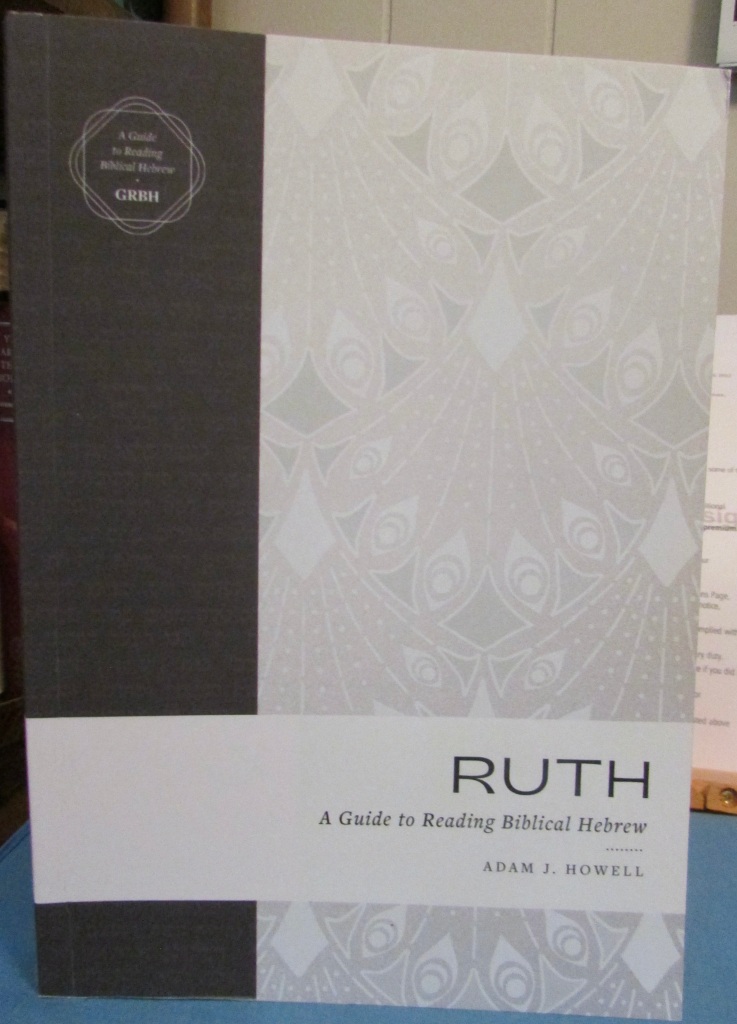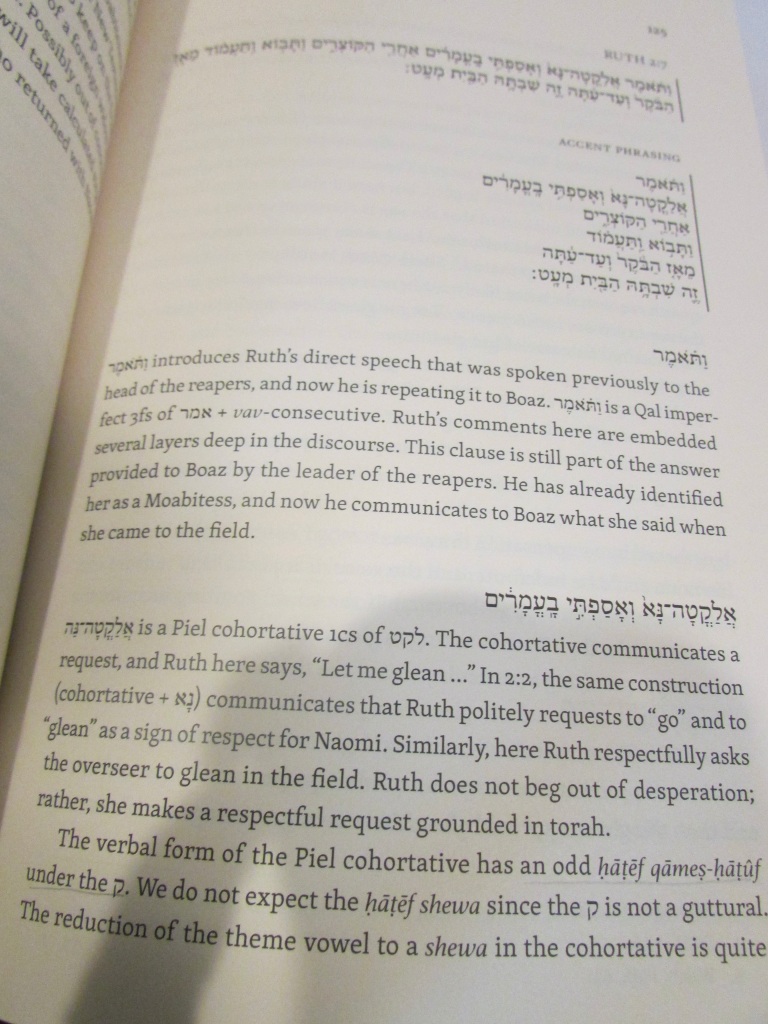Adam J. Howell, Ruth: A Guide to Reading Biblical Hebrew (Bellingham, WA: Lexham Academic, 2022).
I appreciate Lexham providing this volume for review. Their provision did not impact my review. On a personal note, I enjoyed reading this volume while preparing for my viva voce.
Introduction
Howell has recently published Ruth: An Illustrated Hebrew Reader’s Edition through GlossaHouse (2020). For my review of this volume, see here. The Illustrated Reader simply presents the Hebrew text and contextualises it by including appropriate drawings to visualise the action. This volume through Lexham discusses the morphology and grammar of the Hebrew text of Ruth. These volumes could be used together by the student.
I am aware of several other Hebrew reader’s based on Ruth.
- A. R. S. Kennedy, The Book of Ruth: The Hebrew Text with Grammatical Notes and Vocabulary (Texts for Students 42; London: SPCK, 1928).
- Donald R. Vance, A Hebrew Reader for Ruth (Peabody, MA: Hendrickson, 2003).
- Robert B. Chisholm Jr., A Workbook for Intermediate Hebrew: Grammar, Exegesis, and Commentary on Jonah and Ruth (Grand Rapids, MI: Kregel, 2006).
- John R. Wilch, Concordia Hebrew Reader: Ruth (St. Louis: Concordia, 2010).
- Robert D. Holmstedt, Ruth: A Handbook on the Hebrew Text (Baylor Handbook on the Hebrew Bible; Waco, TX: Baylor University Press, 2010).

Howell states in his introduction that his attention to morphology, the te’amim, and the Masoretic parva are what distinguishes this volume. Holmstedt attends to the syntax and morphology of the Hebrew text of Ruth. Vance parses the various verbal and nominal forms in the book without much comment. Wilch notes elements that relate to the discourse and literary nature of the text as well as discusses syntax. Kennedy explains elements that would be difficult for the beginning student (e.g., odd orthography and morphology, strange syntax, difficult parsing, etc.). Chisholm asks questions to encourage the student to explore syntax, morphology, and grammar. This illustrates that Howell’s approach is not entirely unique but important nonetheless as it stands in a stream of previous publications attempting to do the same thing for the beginning student.
It should be noted that Howell is very conscious of elements in the text which hinder the beginning student. He attends to all aspects of morphology and explains it in a simple way so the student can strengthen their understanding. The extensive attention to basic descriptions of morphology is unique among these readers. Howell has the beginning student in mind when creating this volume. Second-year students at his institution read through and commented on the book. He focuses on things with which beginning students tend to struggle, especially morphology. Howell chooses Ruth since it is often read in beginning and intermediate Hebrew classes.
Terminology
Howell uses the terms perfect and Imperfect to describe a qatal and yiqtol respectively. To describe tense/aspect, he uses the terms “perfective” and “imperfective.” A sentence is defined by the first element in the sentence. A nominal or verbal sentence, therefore, is one that either begins with a noun or verb. A nominal sentence is not necessary a verbless sentence in his terminology. He understands Hebrew to be a V-S language. In these ways, Howell’s approach has several differences especially from Holmstedt’s volume on Ruth and from the Baylor Handbooks on the Hebrew Bible in general. Additionally, Howell is following closely the descriptions in Russell Fuller and Kyoungwon Choi, Invitation to Biblical Hebrew Syntax: An Intermediate Grammar (Grand Rapids, MI: Kregel, 2017). For example, he understands construct phrases to have an implied preposition between the construct and abstract noun (see Invitation to Biblical Hebrew Syntax §12).
Layout
Howell presents the Hebrew text and a translation of the pericope at the beginning of a section. He subsequently deals with each individual verse. He uses the Hebrew text from the Lexham Hebrew Bible which he supplements with the textual notes in BHS and BHQ. He arranges the verse first as prose and then uses the te’amim to divide the verse. Finally, he discusses aspects of the verse.

Comments in Ruth: A Guide to Reading Biblical Hebrew
Howell does indeed focus on the morphology of the text and the te’amim as he promises in the introduction. He also discusses theological aspects of the text which will keep the student engaged and remind them why they have come to do this work. Howell’s comments are succinct. His writing style is easily accessible and will not cause the student to stumble over the discussion of grammatical or morphological minutiae. He discusses most issues repeatedly as they appear in the text so that the student will begin to see the pattern and logic of Hebrew as they work through the entirety of Ruth. The syntactic discussion is not as full as in Holmstedt’s volume but appears at points. Some discussions are a bit loquacious but this is intentional to engage the student. The goal of the discussion in this volume is for the student to see how the present morphological forms of the text have come to be from a linguistic perspective by explaining the phonetic changes represented. In this way, the student will become increasing aware of divergences in the orthography and morphology of Hebrew. This will help the student progress nicely through the text of the Hebrew Bible.
His discussion of morphology lends itself to textual criticism. For example, the weqatal 2fs form of הלך appears twice in Ruth 2:9 as וְהָלַכְתִּ and וְהָלַכְתְּ. The vowel under the suffix is unexpectedly a hireq in the first form (i.e., וְהָלַכְתִּ) in L (but not in A and Cambridge 1753) while the expected form with a shewa (i.e., וְהָלַכְתְּ) appears in the second case in L, A, and Cambridge ms 1753. This leads to a discussion of differences in manuscripts (L, A, and Cambridge ms 1753) as well as the possibility that the second feminine singular pronoun was originally אַתִּי (cf. Syriac, Arabic, and Ethiopic) instead of אַתְּ (see pp. 135-136). In the same way, the mappiq in the א in L (but not in A and Cambridge ms 1753) in Ruth 2:10 (pp. 141-142) probably shows that it should be read a consonant in this word (cf. the mappiq in a final ה).
Conclusion
This is a great volume for the beginning student seeking to read the Hebrew text but who is often perplexed by the various phonetic, orthographic, and morphological forms and features encountered. While the volume needs to be supplemented regarding the syntax of Ruth, in my opinion (e.g., by Holmstedt’s volume), it is an excellent resource for explaining the morphology of Hebrew and its various orthographic manifestations. The student will enjoy working through the text and puzzling out the morphological issues encountered.
I certainly hope that Lexham makes this into a series!!
Typos
- p. 17 (first sentence in last paragraph) יְהוּדָ֗ה מִבֵּ֧ית לֶ֣חֶם should be מִבֵּ֧ית לֶ֣חֶם יְהוּדָ֗ה
- p. 26 (last word of full paragraph) vayyiśĕ’û should be vayyiśśĕ’û
- p. 170 (the second sentence in the last full paragraph) “However, it could also be an infinitive + מִן + a 3fs suffix…” should be מִן + an infinitive + a 3fs suffix
- p. 232 (last sentence) 2:11 should be 3:11


Can anyone provide assistance on how to print an article from this site?
LikeLike
Once you open the article you want, then press Control (Ctrl) + P.
LikeLike